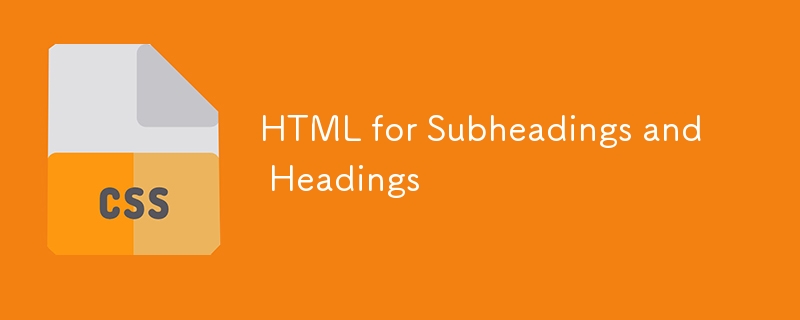HTML for Subheadings and Headings
This article discusses the best HTML writing method for subtitles and large titles in web title structure. The authors enumerate a variety of solutions and analyze their respective semantics and accessibility issues.

The article first introduces common mistakes:<h3></h3> Nesting<h2></h2> , that is, the sub-title is on top and the big title is on bottom. The authors believe that this approach violates semantics because the visual size does not represent semantic hierarchy. This structure can make it difficult for assistive technologies (such as screen readers) to understand the structure of content and affect accessibility.
Next, the author proposes several alternatives:
Plan 1: Reversal<h2></h2> and<h3></h3> order. Set the subtitle to<h2></h2> , set the title as<h3></h3> . The author believes that this approach is more reasonable if the subtitle is semantically more important.
Solution 2: Use one<h2></h2> And one
. Put the subtitle Medium, use the title<h3></h3> . This is visually feasible, but the subtitles may be ignored by screen reader users. Solution 3: Use<hgroup></hgroup> element. The author tried to use<hgroup></hgroup> Pack the title and subtitles and control the visual order through CSS. But the author points out that this approach may not be friendly enough for screen reader users.
Solution 4: Use a single<h2></h2> , and use<strong></strong> Mark the subtitle. This is semantically more concise and controlled by CSS<strong></strong> , the style of the , achieves visual distinction. The author recommends using punctuation marks such as colons between sub-headings and large titles to make them more semantically coherent.
Solution 5: Use the ARIA role role="doc-subtitle" . The author introduces the ARIA role role="doc-subtitle" to represent subtitles. Although the browser supports this role in varying degrees, overall, it is a viable solution.
Finally, the author also discussed some unrecommended practices, such as using<label></label> Elements or pseudo-elements to achieve visual effects, as these methods affect accessibility and content findability.
The article summarizes the advantages and disadvantages of various methods and suggests that the most appropriate solution should be selected according to the actual situation, with semantics and accessibility priority. The author emphasizes that when selecting HTML elements, you should focus on semantics rather than just considering visual effects.
The above is the detailed content of HTML for Subheadings and Headings. For more information, please follow other related articles on the PHP Chinese website!

Hot AI Tools

Undresser.AI Undress
AI-powered app for creating realistic nude photos

AI Clothes Remover
Online AI tool for removing clothes from photos.

Undress AI Tool
Undress images for free

Clothoff.io
AI clothes remover

Video Face Swap
Swap faces in any video effortlessly with our completely free AI face swap tool!

Hot Article

Hot Tools

Notepad++7.3.1
Easy-to-use and free code editor

SublimeText3 Chinese version
Chinese version, very easy to use

Zend Studio 13.0.1
Powerful PHP integrated development environment

Dreamweaver CS6
Visual web development tools

SublimeText3 Mac version
God-level code editing software (SublimeText3)

Hot Topics
 1664
1664
 14
14
 1423
1423
 52
52
 1317
1317
 25
25
 1268
1268
 29
29
 1246
1246
 24
24
 How to Create an Animated Countdown Timer With HTML, CSS and JavaScript
Apr 11, 2025 am 11:29 AM
How to Create an Animated Countdown Timer With HTML, CSS and JavaScript
Apr 11, 2025 am 11:29 AM
Have you ever needed a countdown timer on a project? For something like that, it might be natural to reach for a plugin, but it’s actually a lot more
 HTML Data Attributes Guide
Apr 11, 2025 am 11:50 AM
HTML Data Attributes Guide
Apr 11, 2025 am 11:50 AM
Everything you ever wanted to know about data attributes in HTML, CSS, and JavaScript.
 A Proof of Concept for Making Sass Faster
Apr 16, 2025 am 10:38 AM
A Proof of Concept for Making Sass Faster
Apr 16, 2025 am 10:38 AM
At the start of a new project, Sass compilation happens in the blink of an eye. This feels great, especially when it’s paired with Browsersync, which reloads
 While You Weren't Looking, CSS Gradients Got Better
Apr 11, 2025 am 09:16 AM
While You Weren't Looking, CSS Gradients Got Better
Apr 11, 2025 am 09:16 AM
One thing that caught my eye on the list of features for Lea Verou's conic-gradient() polyfill was the last item:
 A Comparison of Static Form Providers
Apr 16, 2025 am 11:20 AM
A Comparison of Static Form Providers
Apr 16, 2025 am 11:20 AM
Let’s attempt to coin a term here: "Static Form Provider." You bring your HTML
 How to Build Vue Components in a WordPress Theme
Apr 11, 2025 am 11:03 AM
How to Build Vue Components in a WordPress Theme
Apr 11, 2025 am 11:03 AM
The inline-template directive allows us to build rich Vue components as a progressive enhancement over existing WordPress markup.
 PHP is A-OK for Templating
Apr 11, 2025 am 11:04 AM
PHP is A-OK for Templating
Apr 11, 2025 am 11:04 AM
PHP templating often gets a bad rap for facilitating subpar code — but that doesn't have to be the case. Let’s look at how PHP projects can enforce a basic
 The Three Types of Code
Apr 11, 2025 pm 12:02 PM
The Three Types of Code
Apr 11, 2025 pm 12:02 PM
Every time I start a new project, I organize the code I’m looking at into three types, or categories if you like. And I think these types can be applied to




